The world is home to a variety of rare and unusual fruits that are cherished for their unique flavors, captivating aromas, and distinct appearances. From the Jabuticaba, which grows directly on the trunk of its tree, to the Mangosteen, known as the “queen of fruits,” these rare fruit varieties offer a tantalizing glimpse into the extraordinary diversity of nature. Let’s embark on a journey to uncover these hidden fruit treasures.
Key Takeaways:
- Explore the world of rare fruits and discover their unique flavors and aromas.
- Uncover the fascinating Jabuticaba, a fruit that grows on the trunk of its tree.
- Learn about the Mangosteen, hailed as the “queen of fruits” for its exquisite taste.
- Experience the polarizing Durian, known as the “king of fruits,” with its distinctive odor.
- Discover the vibrant and juicy Rambutan, a tropical delight native to Southeast Asia.
The Jabuticaba – A Rare Delicacy from Brazil
The Jabuticaba is an extraordinary fruit that originates from Brazil, making it a unique and rare delicacy. This fascinating fruit is known for its distinctive growth habit, as it grows directly on the trunk of its tree. Its deep purple color and grape-like flavor set it apart, making it a sought-after treasure among fruit enthusiasts.
When you indulge in the Jabuticaba, you’ll experience a burst of flavor reminiscent of ripe grapes. Its sweet and juicy flesh delights the taste buds, leaving a lingering and satisfying taste. The unique growing pattern of the Jabuticaba and its tantalizing flavor make it a true botanical wonder worth exploring.
Discovering this extraordinary fruit is like stumbling upon nature’s hidden gem. Its vibrant color and enticing aroma make it an irresistible treat for the senses. Whether enjoyed fresh or used in various culinary creations like jams and wines, the Jabuticaba is a fruit that is sure to captivate and impress.
The Jabuticaba’s fascinating appearance and grape-like flavor make it a rare and cherished fruit. Its unique growth habit and incredible taste truly make it a delicacy to remember.
The Jabuticaba at a Glance:
| Origin | Flavor | Growing Habit |
|---|---|---|
| Brazil | Grape-like | Grows directly on trunk |
As seen in the table above, the Jabuticaba originates from Brazil and is best known for its grape-like flavor. However, what truly sets it apart is its unique growing habit of fruiting directly on the trunk of its tree.
Next, let’s dive into another rare fruit variety, the Mangosteen, and discover why it is hailed as the exquisite “queen of fruits” in Southeast Asia.
The Mangosteen – The Exquisite “Queen of Fruits”
Hailing from Southeast Asia, the Mangosteen is often referred to as the “queen of fruits” for its exquisite taste and captivating aroma. Its deep purple rind conceals delicate, juicy segments that offer a unique combination of sweetness and tanginess. The Mangosteen is highly sought after and treasured for its exceptional flavor.
| Key Features | Details |
|---|---|
| Taste | The Mangosteen has a delectable blend of sweet and tangy flavors, making it a true tropical delight. |
| Appearance | The fruit’s deep purple rind hides its juicy, white segments, giving it an alluring appeal. |
| Origin | Southeast Asia, specifically Indonesia, Malaysia, Thailand, and the Philippines. |
| Significance | The Mangosteen is highly valued in Southeast Asian cuisines, where it is often used in desserts, juices, and salads. |
With its exceptional flavor and rich cultural significance, the Mangosteen is a true botanical treasure that deserves a place on every fruit lover’s bucket list.
The Durian – A Polarizing Fruit with a Strong Identity
The Durian, also known as the “king of fruits,” is a unique and polarizing delicacy. It has gained notoriety for its distinctive odor, which some find overpowering. However, for those willing to brave the smell, the Durian offers a culinary adventure like no other.
The Durian has a loyal following who appreciate its rich, creamy texture and complex flavor profile. Its taste combines elements of sweetness, savoriness, and hints of bitterness, creating a truly unique culinary experience.
While its odor may divide opinions, the Durian’s strong identity sets it apart from other fruits. Its reputation as the king of fruits is well-deserved, as no other fruit can match its boldness and distinctiveness.
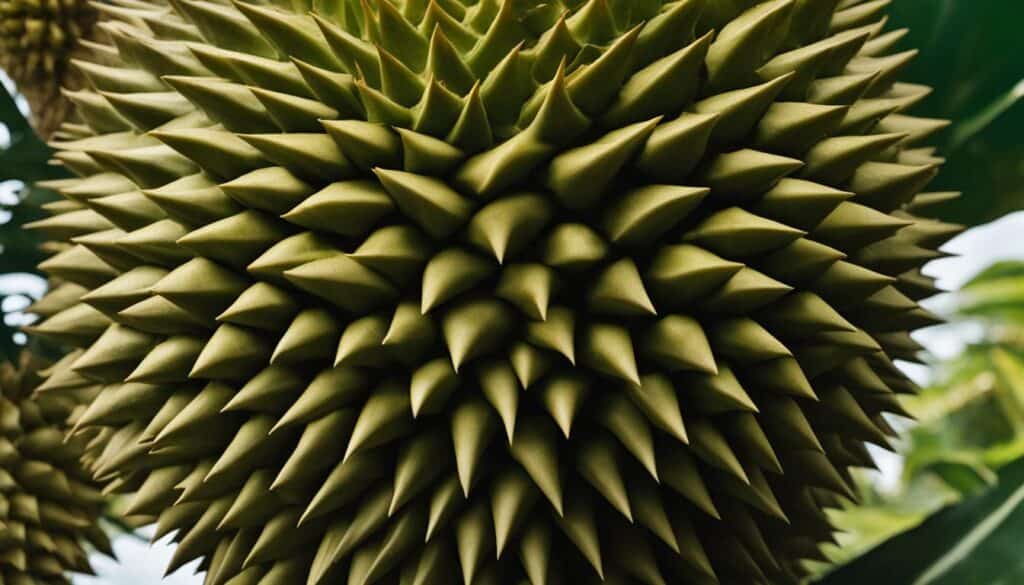
Love it or hate it, the Durian is a fruit that cannot be ignored. Its presence sparks curiosity and intrigue, making it a topic of conversation among food enthusiasts and adventurers. Whether you’re drawn to its creamy texture, complex flavor, or simply enjoy the thrill of trying something unique, the Durian is a fruit that demands attention.
The Rambutan – A Vibrant and Juicy Tropical Delight
Native to Southeast Asia, the Rambutan is a small fruit covered in vibrant red, hairy spines. Once peeled, it reveals a translucent and juicy flesh with a pleasantly sweet flavor, often compared to a lychee. The Rambutan’s striking appearance and refreshing taste make it a beloved tropical delight.
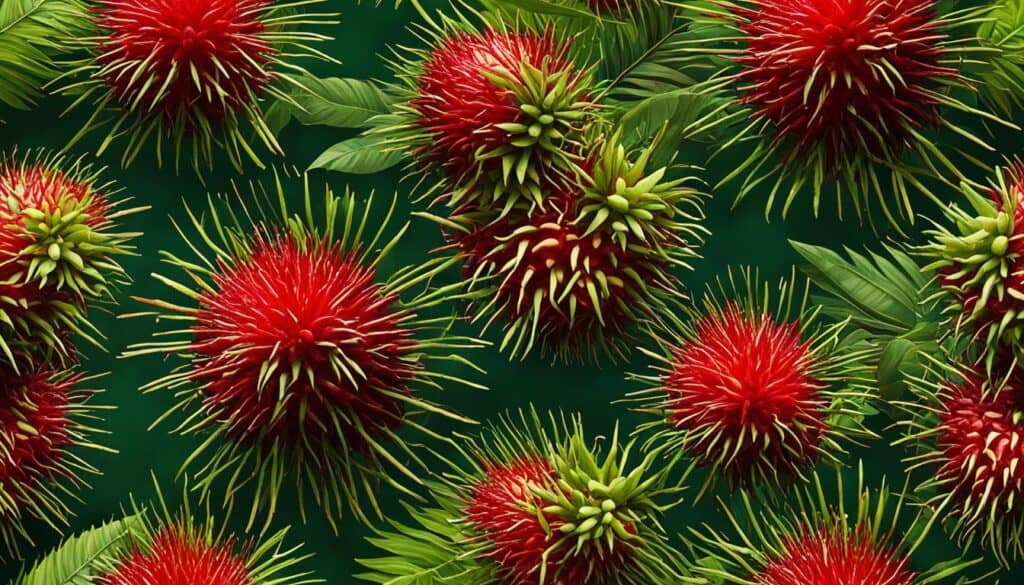
Why Rambutan is a Must-Try Tropical Fruit?
When it comes to tropical fruits, the Rambutan stands out with its unique visual appeal and irresistible taste. Here are a few reasons why you should give this vibrant fruit a try:
- The Rambutan’s vibrant red spines instantly catch the eye, making it a captivating addition to any fruit bowl or dessert platter.
- Its juicy and translucent flesh offers a burst of refreshing sweetness that lingers on the taste buds.
- Many describe the flavor of Rambutan as a tropical blend of sweet and slightly tangy notes, reminiscent of a lychee.
- With a high water content, the Rambutan is not only delicious but also hydrating, making it an excellent choice for hot summer days.
- Rich in antioxidants, vitamins, and minerals, Rambutan is a nutritious fruit that can contribute to a balanced and healthy diet.
The next time you have the chance, don’t miss the opportunity to try this tropical delight. The Rambutan’s vibrant appearance and juicy, sweet flesh will transport your taste buds to Southeast Asia’s lush tropical landscapes.
The Ackee – A Jamaican Favorite with Nutty Notes
When it comes to Jamaican cuisine, one fruit stands out for its distinctive flavor and versatility – the Ackee. Originating from West Africa but now synonymous with Jamaican culture, the Ackee is a small red pear-shaped fruit that adds depth and character to traditional dishes.
However, it’s important to note that only the yellow arils of the Ackee fruit are edible. These arils, when cooked, offer a buttery texture and a subtle, nutty taste that enhances the overall flavor profile of any dish.
Whether it’s paired with saltfish in the classic Jamaican dish “Ackee and Saltfish” or incorporated into flavorful stews, the Ackee brings a unique and delightful taste to the table. Its nutty notes add complexity and richness, making it a true Jamaican favorite.
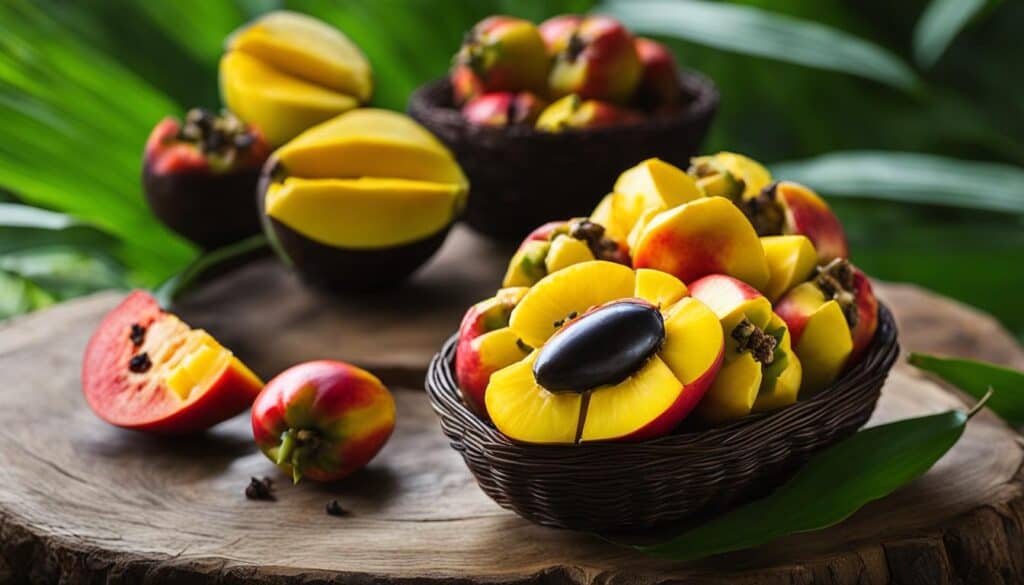
Jamaican Ackee and Saltfish Recipe
- Ingredients:
- 1 can of Ackee (drained and rinsed)
- 1/2 pound of saltfish (codfish), soaked overnight and boiled until tender
- 1 onion, chopped
- 2 cloves of garlic, minced
- 1 tomato, diced
- 1 bell pepper, sliced
- 2 scotch bonnet peppers, seeded and minced
- 2 tablespoons of vegetable oil
- 1/2 teaspoon of black pepper
- 1/2 teaspoon of dried thyme
- 1/2 teaspoon of paprika
- Salt to taste
- Instructions:
- In a large skillet, heat the vegetable oil over medium heat.
- Add the onion, garlic, and scotch bonnet peppers. Sauté until the onions are translucent.
- Add the saltfish, tomato, bell pepper, black pepper, dried thyme, and paprika. Cook for 5 minutes.
- Add the drained Ackee and stir gently to combine. Cook for another 5 minutes, taking care not to break up the Ackee too much.
- Season with salt to taste.
- Serve hot with steamed rice, fried plantains, or Jamaican hard dough bread.
“The Ackee is not just a fruit, it’s an integral part of Jamaican culture and cuisine. Its unique nutty taste adds a delightful dimension to our traditional dishes, making them truly special.” – Chef Marcus Samuelsson
So if you’re ready to experience the nutty taste of Jamaican cuisine, be sure to try the Ackee in your next culinary adventure. Its flavor and versatility will surely leave you craving for more!
The Buddha’s Hand – A Fragrant and Citrusy Wonder
One of the most intriguing and visually captivating fruits in the world is the Buddha’s Hand. Native to China and India, this unique fruit gets its name from its striking appearance, which resembles a citron with multiple finger-like segments. While it lacks pulp, the Buddha’s Hand is highly valued for its fragrant rind, which adds a delightful aroma to any environment.
The fragrant rind of the Buddha’s Hand is not only pleasing to the senses but also serves various purposes. Its enticing scent makes it a popular choice as a natural air freshener, filling rooms with a refreshing citrus aroma. In addition, the rind of this exotic fruit is often used in culinary creations to add a burst of citrusy zest. Whether it’s infusing flavor into desserts, cocktails, or savory dishes, the Buddha’s Hand brings a unique and invigorating twist to any recipe.
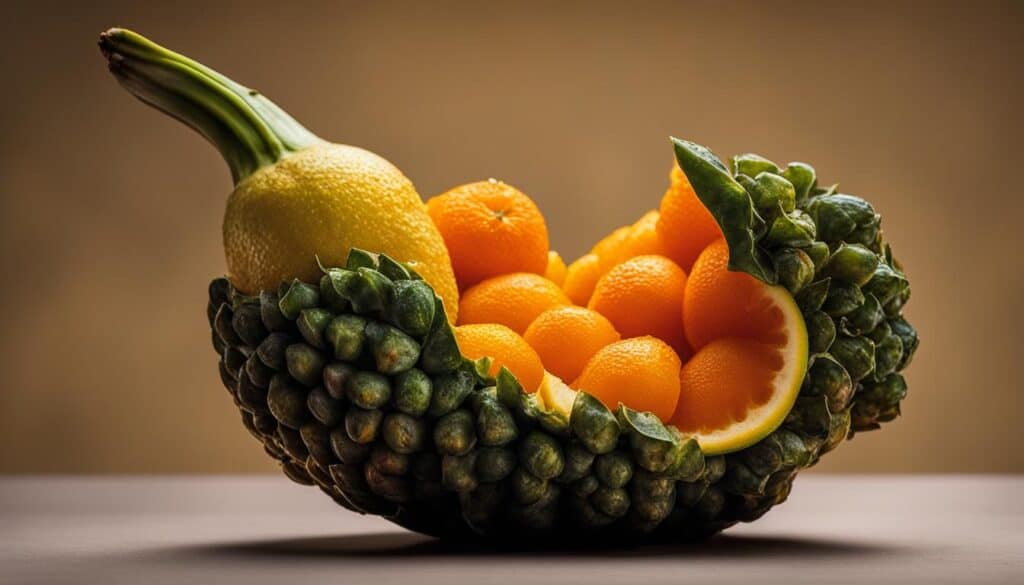
With its vibrant fragrance and citron-like appearance, the Buddha’s Hand is not only a culinary wonder but also a delightful decorative element. Its intricate shape and bright color make it a striking centerpiece in fruit bowls or as a decorative accent in the home.
Experience the captivating wonder of the Buddha’s Hand for yourself and explore the countless possibilities it offers in enhancing both the aroma and flavor of your favorite dishes.
The Cherimoya – A Creamy Custard-Like Delight
Nestled in the heart of the Andean region in South America, the Cherimoya, also known as the custard apple, is a tropical fruit that delights the senses with its creamy, custard-like texture.
When you take a bite of this luscious fruit, it’s like indulging in a spoonful of velvety smoothness. The Cherimoya’s rich and decadent texture is reminiscent of custard, creating a truly luxurious experience for your taste buds.
But it’s not just the texture that sets the Cherimoya apart. Its flavor profile is a delightful blend of pineapple, banana, and strawberry, making each bite a tantalizing explosion of sweetness with a hint of tanginess.
This exotic fruit is cherished for its unique combination of tropical flavors and velvety consistency, making it a treasure from the bountiful Andean region.

Health Benefits of Cherimoya
The Cherimoya not only pleases the palate but also offers several health benefits. It is a good source of vitamin C, providing a boost to your immune system. Additionally, the fruit is rich in dietary fiber, promoting healthy digestion.
Moreover, the Cherimoya contains antioxidants, which help fight against free radicals and protect your body from oxidative stress. These antioxidants also contribute to healthy skin and overall well-being.
“The Cherimoya’s creamy texture and tropical flavor make it a perfect ingredient for smoothies, desserts, or simply enjoyed on its own. It’s a true indulgence that brings a taste of the Andean paradise to your plate.”
– Maria Sanchez, Nutritionist
Enjoying Cherimoya
The Cherimoya can be enjoyed in various ways. Slice it open and eat it fresh to savor its natural goodness. You can also use it to enhance the flavor and texture of your favorite smoothies or incorporate it into desserts like ice cream, pies, and custards.
This versatile fruit is a must-try for all fruit enthusiasts looking for a unique and satisfying treat. With its velvety texture, tropical essence, and health benefits, the Cherimoya is truly a custard-like delight that leaves a lasting impression.
| Cherimoya Nutrition Facts | |
|---|---|
| Vitamin C | 15% of the daily recommended intake |
| Dietary Fiber | 5 grams per serving |
| Calories | 90 calories per serving |
| Antioxidants | Rich in antioxidants |
Conclusion
The world of rare fruits is a captivating realm that showcases the extraordinary diversity and beauty of our planet’s botanical treasures. Each rare fruit, from the Jabuticaba to the Cherimoya, offers a unique sensory experience that tells a story of nature’s boundless creativity. Exploring these rare fruits allows us to appreciate the richness of our planet’s biodiversity and highlights the need to protect and conserve these fragile ecosystems.
By embracing and preserving rare fruits, we not only savor their delectable flavors and indulge in their exotic aromas, but we also contribute to the conservation of their natural habitats. Rare fruits are not just culinary wonders; they are also ambassadors of biodiversity, reminding us of the interconnectedness of all living things.
As we continue to explore and discover the wonders of rare fruits, let us be mindful of the importance of conservation efforts. Through sustainable practices and the protection of biodiverse environments, we can ensure that future generations will also have the opportunity to marvel at the botanical treasures that these rare fruits represent.
FAQ
What is the most rare fruit?
The world is home to a variety of rare and unusual fruits, but one of the most rare fruits is the Jabuticaba from Brazil.
What makes the Jabuticaba unique?
The Jabuticaba is truly unique because it grows directly on the trunk of its tree, giving it a fascinating appearance.
What does the Jabuticaba taste like?
The Jabuticaba has a deep purple color and a sweet, grape-like flavor that is considered a rare delicacy.
Where does the Mangosteen originate from?
The Mangosteen originates from Southeast Asia and is often referred to as the “queen of fruits” for its exquisite taste.
What does the Mangosteen taste like?
The Mangosteen has a delicious combination of sweetness and tanginess, with delicate, juicy segments hidden beneath its deep purple rind.
What is the Durian known for?
The Durian is known as the “king of fruits” and has a distinctive odor that some find overpowering.
What does the Durian taste like?
Despite its polarizing smell, the Durian has a rich, creamy texture and a complex flavor that combines sweetness, savory notes, and hints of bitterness.
Where is the Rambutan native to?
The Rambutan is native to Southeast Asia and is a small fruit covered in vibrant red, hairy spines.
What does the Rambutan taste like?
Once peeled, the Rambutan reveals a translucent and juicy flesh with a pleasantly sweet flavor, often compared to a lychee.
Where does the Ackee originate from?
The Ackee originates from West Africa but is synonymous with Jamaican cuisine.
What part of the Ackee fruit is edible?
Only the yellow arils of the Ackee fruit are edible, offering a buttery texture and a subtle, nutty taste when cooked.
Where is the Buddha’s Hand native to?
The Buddha’s Hand is native to China and India and has a striking appearance resembling a citron with multiple finger-like segments.
How is the Buddha’s Hand fruit used?
While it lacks pulp, the fragrant rind of the Buddha’s Hand is often used as a natural air freshener or for adding citrusy zest to dishes.
What is the Cherimoya also known as?
The Cherimoya is often called the “custard apple” due to its creamy, custard-like texture.
What does the Cherimoya taste like?
The Cherimoya has a unique flavor profile, combining hints of pineapple, banana, and strawberry, making it a tropical fruit delicacy.
What do rare fruits showcase?
Rare fruits showcase the extraordinary diversity and beauty of our planet’s botanical treasures.
Why is it important to explore rare fruits?
Exploring rare fruits allows us to appreciate the richness of our planet’s biodiversity and highlights the need to protect and conserve these fragile ecosystems.

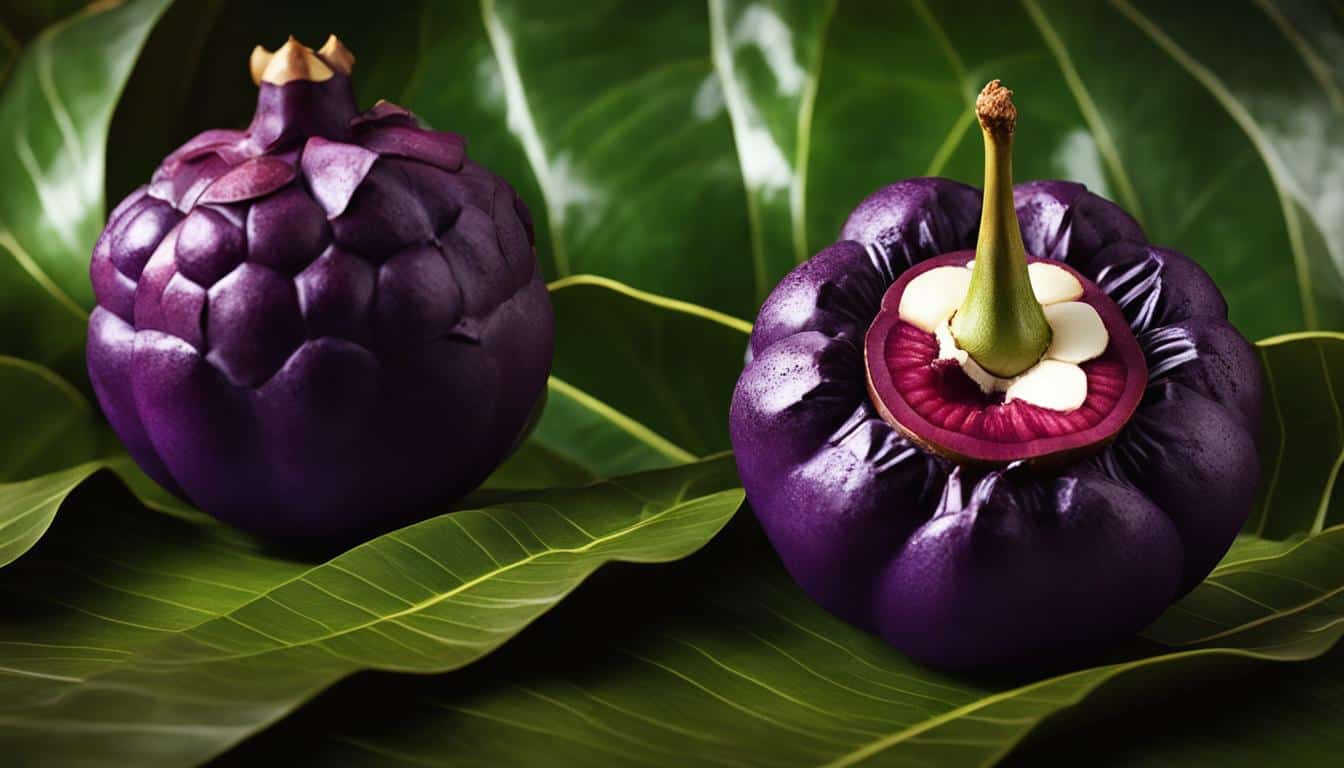



Leave a Reply